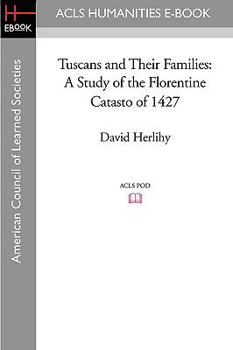Tuscans and Their Families: A Study of the Florentine Catasto of 1427
Select Format
Select Condition 
Book Overview
No Synopsis Available.
Format:Paperback
Language:English
ISBN:1597405159
ISBN13:9781597405157
Release Date:August 2008
Publisher:ACLS History E-Book Project
Length:436 Pages
Weight:1.28 lbs.
Dimensions:0.9" x 6.0" x 9.0"
Customer Reviews
2 ratings
A Model of Historical Methodology
Published by Thriftbooks.com User , 15 years ago
The Florentine Catasto of 1427 - a census of the population of Tuscany and of their wordly possessions - had been waiting for an exhaustive analysis ever since it was gathered. One might almost think the Florentines foresaw the invention of the computer, since they had no equivalent way of making use of their own data. In the 1970s, David Herlihy and Christiane Klapisch-Zaber, both academes of the highest rank in the USA and France respectively, constructed a model of statistical analysis, with their already quaint pre-gigabyte computers, which is still a founding model of the use of the computer in historiography. Any serious demographer would be richly rewarded by examining this text in terms of methodology. The sixty tables and graphs which accompany the text are also superb models of clarity. So what did the analysis of the Catasto reveal? A lot, my friends, some of it just what you'd expect but sone of it quite surprising. For example, the wealth of the richest 1% of households in the city of Florence was equal to that of the poorest 87% of Tuscans urban and rural. Sound familiar, Americans? But on the surprising side, the scions of wealth tended to marry younger - men especially - and to have more children than the "middling" people, and the poorest people tended never to breed at all. Another surprise: Tuscany in 1427 was considerably more an urban culture than many historians of the Renaissance have assumed. Of all the inhabitants of Tuscany, 27% lived in the ten largest cities, and 14% in Florence alone. Here's an interesting paragraph concerning the extreme maldistribution of wealth in 1427: "Everywhere, the deprived workers, eking out a living on the margins of subsistence, had little incentive to better their plight; strenuous efforts might win them greater income, but this would largely benefit others -- the host claiming one-half of the harvest...or urban creditors. Many in Tuscan society were too poor to generate much demand for the products of the regional economy. Feeble local demand for goods of mass consumption was probably a principal reason why the Tuscan economy, so well endowed with skills, so promising in the late Middle Ages, could not break through to new forms of industrial organization..." Behold, disciples of Milton Friedman and proponents of trickle-down economics! Your pipe-dreams were tested half a millennium ago and failed miserably. This text, by the way, was published in America as part of the Yale Series of Economic History. I can't pretend that a category-by-category analysis of a 580-year-old census makes easy reading, but the authors do their best to humanize their demography with fascinating details of ordinary life in the city and countryside of perhaps the most artistically vibrant community that has ever existed. Herlihy's writing style - I presume he's responsible for the English - is clear and concise, and shows no trace of the academic pomp that often spoils translations of French historiography.
Irreplacable resource for the period.
Published by Thriftbooks.com User , 17 years ago
This book is an absolutely essential tool for anybody who seeks to understand the period. By using a series of census-like documents called the Catasto, these researchers have found a number of astonishing things out about a period not famous for information about its lower and middle classes. Getting the information out of the book can be a challenge, but it's all there: information about every phase of life from birth to death as well as income levels, age at marriage and widowhood, employment levels, all accompanied by an array of graphs and maps to better display the information. If you're serious about understanding Renaissance-era Florence, set some room aside on the bookshelf for this one. Chapters: 1. About how Florence's politics and economics work; how the Catasto came about and how it was administered. 2. Various maps showing the Florentine city and environs; distribution of population between cities and countryside; showing the districts of the cities around Florence; populations of villages and towns. 3. Population movements from 1300-1550, with particular attention paid to the Black Death's effects on mortality and births, and also to how people moved from the country to the city and back. 4. Income distributions across the region; information about migrants, peasants, artisans, merchants, and other wage servants. 5. Differences between the genders -- early childhood, adolescence, old age, with regard particularly to the plague years and infant abandonment. 6. Differences between ages; lots of info about age's correlation with income, residence location, and gender. 7. Marriage: age at first marriage, proportions of married vs unmarried, where people lived, and how marriage impacted upward/downward mobility. 8. Births: how they were registered, age of parents, size of families, distribution of birth across the region. 9. Death: Mortality rates and correlations with age and gender. Also, discussion of causes of death. 10. Hearths: Size of household, structure and composition of the family/hearth, and differences between the hearths of wealthy and poor families. 11. Kin: Names and lineage, marital ties and the choosing of friends.




